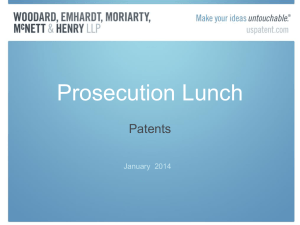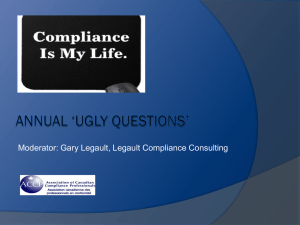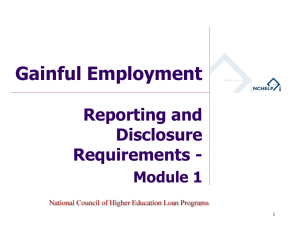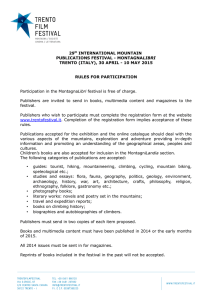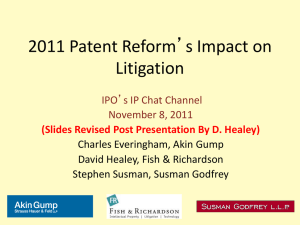Information Disclosure Statements
advertisement
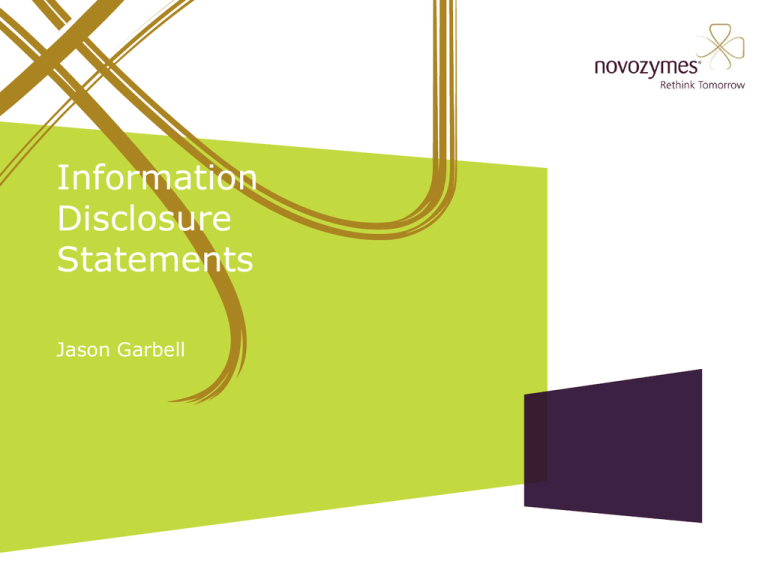
Information Disclosure Statements Jason Garbell The Duty of Disclosure A duty to disclose all information known to be material to patentability. Also called the duty of candor. What is material information? Material information includes: Prior art printed publications (e.g., patent or scientific publications). Prior art cited in search reports of a non-US patent office in a counterpart application or highly related application Information relating to or from a co-pending US Patent application. Related applications by the same applicant or inventors. Publications by the inventors. Public presentations at conferences or trade shows. Offers for sale or public uses of the invention. Information from litigations/oppositions. What is material information? Material information includes: Prior art printed publications (e.g., patent or scientific publications). Prior art cited in search reports of a non-US patent office in a counterpart application or subject matter related application Information relating to or from a co-pending US Patent application. Related applications by the same applicant or inventors. Publications by the inventors. Public presentations at conferences or trade shows. Offers for sale or public uses of the invention. Information from litigations/oppositions. What is material information? Material information includes: Prior art printed publications (e.g., patent or scientific publications). Prior art cited in search reports of a non-US patent office in a counterpart application or subject matter related application Information relating to or from a co-pending US Patent application. Related applications by the same applicant or inventors. Publications by the inventors. Public presentations at conferences or trade shows. Offers for sale or public uses of the invention. Information from litigations/oppositions. Co-pending applications The USPTO will consider all information from any parent application if the application is identified as a continuation, divisional or continuation-in-part of an earlier application. Still may want to submit an IDS to have the references from the parent listed on the front cover of the patent. However, co-pending or related applications which are not parent applications, but which have similar subject matter must be disclosed to the USPTO. Similarly prior art references from such co-pending or related applications may need to be disclosed if material to patentability. What is material information? Material information includes: Prior art printed publications (e.g., patent or scientific publications). Prior art cited in search reports of a non-US patent office in a counterpart application or subject matter related application Information relating to or from a co-pending US Patent application. Related applications by the same applicant or inventors. Publications by the inventors. Public presentations at conferences or trade shows. Offers for sale or public uses of the invention. Information from litigations/oppositions. What is material information? Material information includes: Prior art printed publications (e.g., patent or scientific publications). Prior art cited in search reports of a non-US patent office in a counterpart application or subject matter related application Information relating to or from a co-pending US Patent application. Related applications by the same applicant or inventors. Publications by the inventors. Public presentations at conferences or trade shows. Offers for sale or public uses of the invention. Information from litigations/oppositions. What is material information? Material information includes: Prior art printed publications (e.g., patent or scientific publications). Prior art cited in search reports of a non-US patent office in a counterpart application or subject matter related application Information relating to or from a co-pending US Patent application. Related applications by the same applicant or inventors. Publications by the inventors. Public presentations at conferences or trade shows. Offers for sale or public uses of the invention. Information from litigations/oppositions. Aids to comply with the Duty of Disclosure 1. Question the inventor about the origin of the invention and its point of departure from the closest prior art. 2. Question about possible public uses or sales. 3. List prior publications, knowledge, patents, non-US patents. 4. Inquire as to who is the proper inventor and are there any inventorship disputes. 5. Ask if the “best mode” is disclosed. 6. Remember to cite prior art cited in the specification. The Duty of Disclosure Applies to: Each inventor Each attorney or agent who prepares or prosecutes the application. Every other person who is substantively involved in the preparation or prosecution of the application and is associated with the inventor, assignee or anyone who has an obligation to assign. The Duty Of Disclosure Failure to comply with the duty of disclosure can result in a finding of inequitable conduct/fraud. The patent and related patent applications can be found unenforceable and potential sanctions for fraud. The Duty Of Disclosure The Duty extends until a patent is physically granted. Thus, the Duty extends after a notice of allowance is obtained but before grant. The soon to issue patent must be withdrawn from issuance in order to submit the information. This is done by a petition and the filing of a request for continued examination (RCE) or other continuation application. The Oath or Declaration An oath or declaration must be signed acknowledging this duty of candor. Inventor must be able to understand the oath or declaration so the oath or declaration may need to be translated. Foreign Language References The duty does not require applicants to translate every reference, but only for the applicant not to submit partial translations or explanations that may mislead the USPTO. Options: Translate the entire reference Translate only the relevant part(s) of reference Provide a concise summary of the relevant part(s). Which one is better? Inaccurate statements Care should be taken to insure that inaccurate statements or inaccurate experiments are not introduced into the specification or prosecution.. `For example, stating that an experiment “was run” or “was conducted” when it in fact was not run or conducted is a misrepresentation. Caution, such errors can occur during translation. Information Disclosure Statements Period 1: Before first office action or within three months after filing of the application. Period 2: Before a final office action, notice of allowance or communication which closes prosecution. Period 3: After notice of an allowance, but before payment of the issue fee. Period 4: After payment of the issue fee. Information Disclosure Statements Period 1: Before first office action or within three months after filing of the application. Period 2: Before a final office action, notice of allowance or communication which closes prosecution. Period 3: After notice of an allowance, but before payment of issue fee. Period 4: After payment of issue fee. Information Disclosure Statements IDS submitted in Period 1 shall be considered. No fee. Information Disclosure Statements Period 1: Before first office action or within three months after filing of the application. Period 2: Before a final office action, notice of allowance or communication which closes prosecution. Period 3: After notice of an allowance, but before payment of issue fee. Period 4: After payment of issue fee. Information Disclosure Statements An IDS submitted in Period 2, will be considered with either of the following: 1) Statement that each item of information was cited in a communication from a foreign patent office in a counterpart foreign application not more than three months before filing of the information disclosure statement, and that no item of information was known to any individual with the duty of disclosure more than three months before filing; OR 2) an appropriate fee. Information Disclosure Statements Period 1: Before first office action or within three months after filing of the application. Period 2: Before a final office action, notice of allowance or communication which closes prosecution. Period 3: After notice of an allowance, but before payment of issue fee. Period 4: After payment of issue fee. Information Disclosure Statements Period 3: Submitted after Period 2, but before payment of issue fee, will be considered with both of the following: 1) Statement that each item of information was cited in a communication from a foreign patent office in a counterpart foreign application not more than three months before filing of the information disclosure statement, and that no item of information was known to any individual with the duty of disclosure more than three months before filing; AND 2) an appropriate fee. If you cannot make the statement, you must file an RCE or a continuation. Information Disclosure Statements Period 1: Before first office action or within three months after filing of the application. Period 2: Before a final office action, notice of allowance or communication which closes prosecution. Period 3: After notice of an allowance, but before payment of issue fee. Period 4: After payment of issue fee. Information Disclosure Statements In Period 4, after you have paid the issue fee, the IDS will not be considered. Your only option is to: (a) withdraw the application from issuance by a petition; and (b) file a request for continued examination (RCE) or other continuation application. Information Disclosure Statements What if the patent has granted. What options do you have? - Reexamination - Express abandonment - Choose not to enforce all or part? Information Disclosure Statements Period 1: Before first office action or within three months after filing of the application. Period 2: Before a final office action, notice of allowance or communication which closes prosecution. Period 3: After notice of an allowance, but before payment of issue fee. Period 4: After payment of issue fee. NOTE: The three month period in Period 1 does not apply to RCE applications. Information Disclosure Statements Good Practice Tips: Check to make sure the USPTO examiner signs off on all IDS submissions and there are no non-complying IDS’s. Don’t forget non-parent or related applications Prior art from non-parent or related should also be considered for submission Be careful when submitting only partial translations Don’t forget information cited in the Background on the invention Information Disclosure Statements Good Practice Tips: When translating a patent application into English for submission to the USPTO, be careful of noting the correct tense (e.g., changing a patent example from prophetic to past tense can lead to inequitable conduct claims) Avoid long IDS lists, as you can be accused of burying relevant prior art. If long lists are submitted, considering bringing attention to those which have particular relevance. Consider memos to file explaining why a reference was not submitted. National Stage Applications The USPTO will consider the documents cited in the international search report in a PCT national stage application when form PCT/DO/EO/903 indicates that both the international search report and the copies of the documents are present in the national stage file. Information Disclosure Statement Format USPTO provides a form: PTO/SB/08 Must include a list of all patents, publications, U.S. applications or other information. The US patents and US patent publications are listed separately. The non-US patents and patent publications are listed separately. The non-patent literature is listed separately. Do not need to provide copies of US patents or US patent publications. QUESTIONS JGar@novozymes.com

